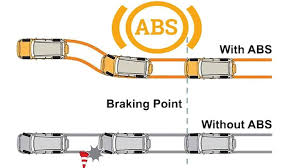


If the Anti-lock Braking System (ABS) light comes on in your dashboard display, it can be alarming.
When you apply firm braking pressure to stop your car, the ABS should prevent your wheels from locking up and skidding. It may seem that your brakes stopped your car, but in fact, the ABS allowed you to maintain steering control throughout the process. Your car’s brakes will still work when the ABS light comes on, but you should have the problem diagnosed as soon as possible. Here, we’ll explore why the ABS light might be turned on, and what you should do if it is.
The ABS light is an indicator on your car’s dashboard that warns you of a problem with the anti-lock braking system. These systems can sense when your wheels start locking in response to heavy braking, and ensure that your wheels do not get locked up when braking. So, if the ABS light is on, there is a malfunction somewhere in the system a the ABS will not engage when you apply the brakes. You will still be able to brake normally, but braking in certain without ABS.
The reason it might come on could be innocuous, or the symptom of a serious failing. Here’s the range of potential reasons for the ABS light to light up:
One of the most common causes of the ABS light coming on is a problem with the wheel speed sensors. These sensors monitor the wheels to determine how fast each one is moving and then relay this information to the course-correction algorithms that the ABS control module uses to adjust the brakes. If dirt or water affects the sensor itself, or the sensor reaches the end of its useful life (as is common with electronics), the information being sent to the control module maybe incorrect, which will make the ABS light come on.
The second can be fixed by adding more brake fluid, though the ABS can fail to work if the brake fluid level is too low (perhaps due to normal brake wear but also because of a leak in the system). The markers seem to be telling us that something is wrong.
Any pronounced wear on brake pads or rotors can cause interference in braking reliability. The presence of worn-out brake components may result in ABS failure due to inability of the system to fully operate, causing the light to illuminate. Appropriate and consistent brake maintenance may help prevent that.
The ABS module process all the data from the sensors – which when necessary engages ABS to prevent wheel lock up. If the ABS module fails because of electrical problems or corrosion then the warning light comes on.
If your ABS light comes on, get ahead of the problem. Here’s what to do:
For starters, give your brake-fluid levels a quick check. If they are low, topping them off should turn the light off. But if they continually drop, you might have a leak that requires immediate attention.
If you are so inclined, check the wheel speed sensors for dirt and debris. If you find need to clean them. light goes out. If to replace the sensors.
Without ABS, your car is more likely to skid when you have to brake suddenly, or on wet or icy roads. Drive slowly, and avoid hard braking until the problem is fixed.
Once the malfunction codes have been cleared (including a test drive to ensure the light no longer comes on), you could get the light to come on again. If the light stays on, it’s time to visit a mechanic, who should be able to run a more comprehensive diagnostic test to determine the problem, and recommend the proper repair.
Your car’s ABS light is warning you that something has gone awry with your vehicle’s anti-lock braking system. Your car will still have regular brakes, but if you ignore the warning light, you could be putting yourself in dangerous, possibly catastrophic, situations. Spending the little time and money it takes to fix the problem, whether it’s low brake fluid, a bad sensor or damaged computer module, is the smart thing to do, and will keep your vehicle performing safely on the road.
